How to Cite | Publication History | PlumX Article Matrix
K. Talat1*, G. L. D. Krupadanam2 and S. Y. Anwar1
1Department of Genetics, Osmania University, Hyderabad India.
2Natural Products Labotatory, Department of Chemistry, Osmania University, Hyderabad - 500 007 India.
Corresponding Author E-mail: talatkh@yahoo.co.in
ABSTRACT: Present study describes in detail isolation and characterization of berberine isolated from the calli cultures of an endangered medicinal plant Coscinium fenestratum. Petiole derived calli cultures were established in MS medium supplemented with 2,4-D and BAP. Air dried calli cultures were homogenized with mortar and pestle then pure methanol was used repeatedly to extract until all the brown color had been removed from the material. Methanol was evaporated and the concentrated extract was separated by preparative TLC by using ethyl acetate: methanol (7:3). The crude extract was loaded into a silica column and eluted with different fractions of solvents from increasing polarity. The yellow fluorescent fraction showed the presence of berberine by TLC, was collected and evaporated by dryness. Yellow colored powder thus obtained was identified by comparing Rf- values on TLC. NMR data of the compound obtained from the calli cultures of C.fenestratum explain the presence of 20 carbons with 18 Protons. Observed molecular weight is 336 and molecular formula C20H18NO4 indicated the compound as berberine which is similar to the authentic sample of berberine and it is about 18 folds higher compared to the petiole of intact plant is the first report of yielding maximum berberine content compare to earlier studies.
KEYWORDS: Coscinium fenestratum; Berberine; calli culture
Download this article as:| Copy the following to cite this article: Talat K, Krupadanam G. L. D, Anwar S. Y. Isolation and Characterization of Enhanced Berberine From the Calli Cultures of Coscinium Fenestratum L. An Endangered Medicinal Liana of Western Ghat India. Biosci Biotechnol Res Asia 2008;6(1) |
| Copy the following to cite this URL: Talat K, Krupadanam G. L. D, Anwar S. Y. Isolation and Characterization of Enhanced Berberine From the Calli Cultures of Coscinium Fenestratum L. An Endangered Medicinal Liana of Western Ghat India. Biosci Biotechnol Res Asia 2008;6(1). Available from: https://www.biotech-asia.org/?p=8098 |
Introduction
Coscinium fenestratum (Gaertn.) Colebr. is a woody climber of Southeast Asia and widely used as a medicinal plant belongs to the family Menispermaceae. Menispermaceae is one among the families having lot of medicinal values. The entire plant of C.fenestratum i.e. from root to fruit has medicinal importance (Narasimhan & Nair 2004). Because of its medicinal uses in Ayurveda, Unani and Siddha systems of medicine, collection of wild plants by the tribal from natural habitat making the species an endangered. It is critically endangered in India, vulnerable in Vietnam, Tare in Singapore and Indeterminate in Srilanka and Malaysia. Crude stem extracts have yielded berberine and Jatrorrhizine (Siwon et al. 1980; Garcia et al. 1970) as major alkaloids. Crude stem extract have antidiabetic (Shirwaikar et al, 2005) antibacterial (Palasuntheram et al, 1982) antifeedant (Jayasinghe et al, 2003) activities. C.fenestratum grows slowly and takes years to isolate berberine from the intact plant. Extensive cultivation of C.fenestratum is hindered due to nonavailibility of the species. Asexual propagation such as grafting and cutting exist but is not economical.
Micropropagation of C.fenestratum has been attempted due to its endemic nature, long duration of cultivation and low yields of berberine from in vivo plants which also limits its utility in the pharmaceutical industry. Though invitro synthesis of berberine from C.fenestratum was first reported by Nair et al (1992), and release and crystallization of berberine in the suspention cultures was also reported (Narsimhan & Nair, 2004). In the present report characterization of enhanced berberine content was studied via physical and chemical analysis by modifying the medium, concentration of plant growth regulators and other invitro conditions.
Materials and Method
Collection & Maintenance of germplasm
The stem cuttings, mature embryos, and small saplings of this plant have been collected from different places of western ghat Karnataka India. viz: Shimoga, Thirthalli, Agumbe, Belthangdi and Kondapur division of Karnataka. The collected plant materials were established in Herbal garden Agriculture University and plant genetics experimental farm, department of genetics, Osmania University, Hyderabad.
Inoculation and Initiation of calli cultures
From the above collected plant material 3 different explants viz:- leaf segments, petiole segments and mature embryos were taken for tissue culture experiments.
The excised plant parts were thoroughly washed in running tap water for 15-20 minutes and subsequently washed with a mild detergent (Bovestin) for 5-10 minutes and washed with sterile distilled water for 3 times. Then the explants were treated with 0.1% mercuric chloride for 3-5 minutes and then immersed in 70% alcohol for 3-5 minutes and rinsed with sterile distilled water for 3 times each 5 minutes duration.
The above mentioned surface sterilized explants were cut into small pieces of 0.5-1 cm in a sterile petridish (petriplate) and were inoculated onto MS medium supplemented with different growth regulators viz:- 2,4-D NAA, IAA, IBA, BAP and KN with different concentrations individually and in combination for callus induction and production of isoquinoline alkaloid berberine. All the experiments were conducted using semisolid medium gelled with 0.4% gelrite under aseptic conditions with light intensity of 1500-1000 lux as well as in the dark at 25±2º C.
Maintenance of calli cultures
Calli cultures thus established were maintained by repeated sub cultures into the same medium every after one week into the fresh medium.
Extraction of berberine from calli cultures
Air dried culture cells (2-3 gm fresh weight) were homogenized with a mortar and pestle then pure methanol was used repeatedly to extract until all the brown color had been removed from the material. Methanol was evaporated and the concentrated extract was separated by preparative TLC by using ethyl acetate: methanol (7:3). The crude extract was loaded into a silica column and eluted with different fractions of solvents from increasing polarity. The yellow fluorescent fraction showed the presence of berberine was collected and evaporated by dryness. Yellow colored powder thus obtained was identified by comparing Rf- values on TLC.
Procedure for initial identification of different classes of natural products:
Dragendroff’s Test 2. Mayer’s Test
Preparation of Dragendroff’s reagent (DRG)
Alkaloid spots were detected by spraying on chromatographic plate with DRG reagent which was prepared following method of Munier and Machboeuf (1969) by dissolving 850mg of bismuth nitrate in a mixture of water and acetic acid in the ratio of 4:1, 8 g of potassium iodide was mixed in 20ml of water. Finally these two solutions were mixed in equal volume. This stock solution was stored in amberlite bottle, at the time of spraying 1ml of stock solution was mixed with 2 ml of acetic acid and combined with 10 ml of water ready for use.
Dragendroff’s Test
Compound (1 mg) was taken in a test tube and dissolved in 2ml of chloroform, 10% solution of Dragendroff’s reagent was then added which gave brick red precipitation indicating the presence of alkaloid.
Mayer’s Test
Compound (1 mg) was taken in a test tube and dissolved in 2ml of 2% H2SO4. A few drops of Mayer’s reagent were added from the side of the test tube. Yellow curdy precipitate indicates positive test for alkaloids.
Characterization of berberine through NMR, MS and HPLC
1H Nuclear Magnetic Resonance (NMR) analysis was made using Bruker Avance – 300 MHz instrument. The chemical shifts were measured with respect to TMS at (d) ppm as internal reference.
1H NMR: – (300 MHz, DMSO-d6): d 9.90 s (8H), d 8.98 s (13H), d 8.25 (d, J=8.0 Hz, 11H), d8.00 (d, J=8.0 Hz, 12H), d 7.80 s (1H), d 7.10 s (4H), 6.20 (s, OCH2d), 4.90 (t, J=6.0 Hz, CH2-6), d 4.10 (s, OCH3), d 4.09 (s, OCH3), d 3.20 (t, J = 6 Hz, CH2-5).
13C Nuclear Magnetic Resonance (NMR) analysis was made by using Bruker Avance – 75 MHz instrument.
13C NMR: 150.0d (s,C-9), 149.0d (s, C-10), 147.0d (s, C-3), 145.0d (s, C-2), 143.0d (d, C-8), 137.0d (s, C-13a), 132.0d (d, C-13), 130.0d (s, C-12a), 126.0d (d, C-12), 123.0d (d, C-11), 121.0d (s, C-8a), 120.3d (s, C-13b), 120.1d (s, C-4a), 108.0d (d, C-4), 105.0d (d, C-1), 102.0d (t, C-16) 61.0d (t, C-6), 57.0d (q, C-14), 55.0d ( q, C-15), 26.0d (t, C-5).
FABMS
The isolated and purified compound was recorded with VG auto spec mass spectrometer using m-nitro benzyl alcohol as a matrix.
EIMS
m/z (re.int %). 336 [(90%). MW], 307 (30), 154 (100), 121(20), 107 (24), 55 (32).
HPLC Analysis
Berberine content in samples was determined by HPLC using a Qualisil BDS C18 reverse phase column, solvents ammonium acetate/acetonitrile/acetic acid 60:40:0.1, flow rate 1ml min-1 and the effluent were monitored at 245 nm. Quantitative analysis was carried out by comparing the peak area with the authentic sample of berberine.
Results and Discussion
In the present study an attempt has been made to analyze the response of different explants, medium, growth regulators and their interaction for callus induction. Different explants have shown varying degree of callusing response. Petiole explant showed relatively more efficiency in callus induction on MS medium supplemented with different growth regulators compared to leaf explant while mature embryos failed to respond, probably due to the dormancy of the seed. The callus was initially brownish black friable and embryogenic but turned dark black may be due to the presence of alkaloid (Photo-1).
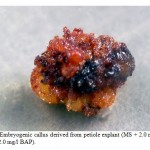 |
Photo:1. Embryogenic callus derived from petiole explant (MS + 2.0 mg/l 2,4-D + 2.0 mg/l BAP). |
The data on berberine content vis-à-vis the cell growth over time showed that, berberine content increased with time in the medium and phyto hormone supplementations (Data Published).
Isolation and characterization of berberine from calli cultures
The air dried culture cells were homogenized with a mortar and pestle then pure methanol was used repeatedly to the extract until all the brown color had been removed from the material. Methanol was evaporated and the concentrated extract was separated by preparative TLC by using ethyl acetate: methanol (7:3). The crude extract was loaded into a silica column and eluted with different fractions of solvents from increasing polarity. The yellow fluorescent fraction showed the presence of berberine, was collected and evaporated by dryness. Yellow colored powder thus obtained was identified by comparing Rf- values on TLC. The band of berberine which appeared yellow in color on TLC showed an intense yellow fluorescence under UV illumination. It tested positive to Dragendroff’s reagent turning the yellow band to yellowish brown.
Structural determination by NMR analysis
Nuclear Magnetic Resonance (NMR) analysis
High resolution NMR data of the compound obtained from the calli cultures of C.fenestratum explain the presence of two CH2 carbon, three CH3 carbon six CH carbon in the compound. The decoupled 13C spectrum explains the presence of nine quaternary carbons (Fig-1). A total of 20 carbon are present in the compound with 18 Protons (Fig-2), observed molecular weight 336 (Fig-3) and molecular formula C20H18NO4 indicated the compound as berberine (fig-4) which is similar to the authentic sample of berberine. Based on the above observations it is concluded that the basic skeleton of berberine alkaloid is present in the compound extracted from the calli cultures of C.fenestratum.
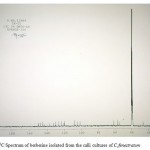 |
Figure 1: 13C Spectrum of berberine isolated from the calli cultures of C.fenestratum. |
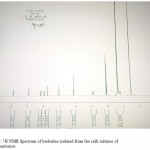 |
Figure 2: 1H NMR Spectrum of berberine isolated from the calli cultures of C.fenestratum.
|
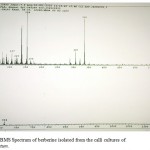 |
Figure 3: FABMS Spectrum of berberine isolated from the calli cultures of C.fenestratum.
|
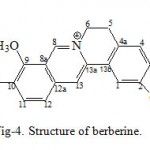 |
Figure 4: Structure of berberine.
|
HPLC
Quantitative analysis of sample was done by High Pressure Liquid chromatography (HPLC) The amount of berberine was quantified by comparing the peak area with the standard sample of berberine with the retention time of 8.3 min.
Conclusion
In conclusion it is observed that light, media, pH of medium, plant growth regulators profoundly influence the biomass and berberine accumulation in the calli cultures of C.fenestratum. The content of berberine in the calli cultures is nearly 18 folds higher compared to the petiole of intact plant is the first report of yielding maximum berberine content compare to earlier studies. Therefore, invitro cultures can be used as an alternate source for berberine production, which is useful in solving the problems faced by plant breeders and phytochemists. However, efforts are underway to yield maximum berberine content in cell cultures of C.fenestratum by adopting different culture techniques such as immobilization, elicitation and precursor feeding, as this medicinal liana is facing genetic erosion. Berberine isolated from the calli cultures was confirmed by comparing 1H NMR, 13 C, FABMS and HPLC.
Acknowledgements
We thank Forest Department, Karnataka, India for providing the plant material to carry out this work successfully and Department of Science and Technology, New Delhi, India, for funding this protocol.
References
- Narasimhan, S. and G.M. Nair. Release of berberine and its crystallization in liquid medium of cell suspension cultures of Coscinium fenestratum (Gaertn.) Colebr. Current Science 86: 1369-1371 (2004).
- Siwon, J., Verpoorte, R., Van essen, G.F.A., Baerhain, S.A. Planta Medica. 38:24 (1980).
- Garcia, L.M.J., A.H. Manchanda, P. Martinod, J. Nabney, F. Robinson. The alkaloids of Arcangelisia Louveirii and Coscinium wallichianum Phytochemistry. 9: 663-664 (1970).
- Shirwaiker, A., K. Rajendran and I.S.R., Punitha. Antidiabetic activity of alcoholic stem extract of C. fenestratum in Streptozotocin-nicotinamide induced type-2 diabetic rats. Ethnopharmocology, 97: 369-374 (2005).
- Palasuntheram, C., K.S., Iyer, L. B.De Silva and T. De Silva . Antibacterial activity of C.fenestratum colebr. against Clostridium tetani. Ind .J. Med. Res., 76: 1913-1988 (1982).
- Jaya Singhe, U.L.B., B.M.M. Kumarihamy, A.G.D. Bandara, J. Wailblinger and W. Kraus. Antifeedant activity of some Srilankan explants. Natural product Research. 17: 5-8 (2003).
- Nair AJ, Sudhakaran PR, Madhusudana JR, Ramakrishna SV. Berberine synthesis by callus and cell suspension cultures of Coscinium fenestratum. Pl. Cell. Tiss & Org. Cult. 29: 7-10 (1992).
- Murashiqe, T., F. Skoog. A revised medium for rapid growth and bioassays with tobacco tissue culture. Physiol plant. 15: 473-497 (1962).
- Munier, R., Macheboeuf. Bull.Soc.Chem.Biol. 33: 846 (1969).

This work is licensed under a Creative Commons Attribution 4.0 International License.





